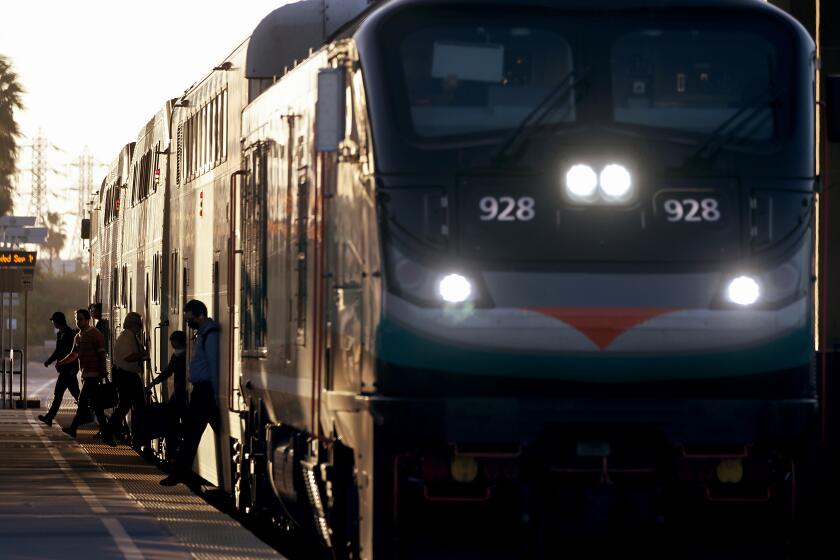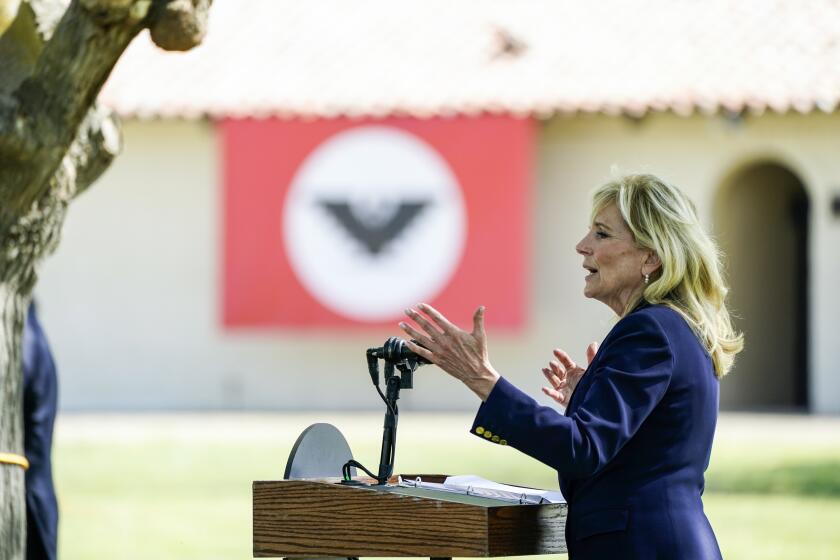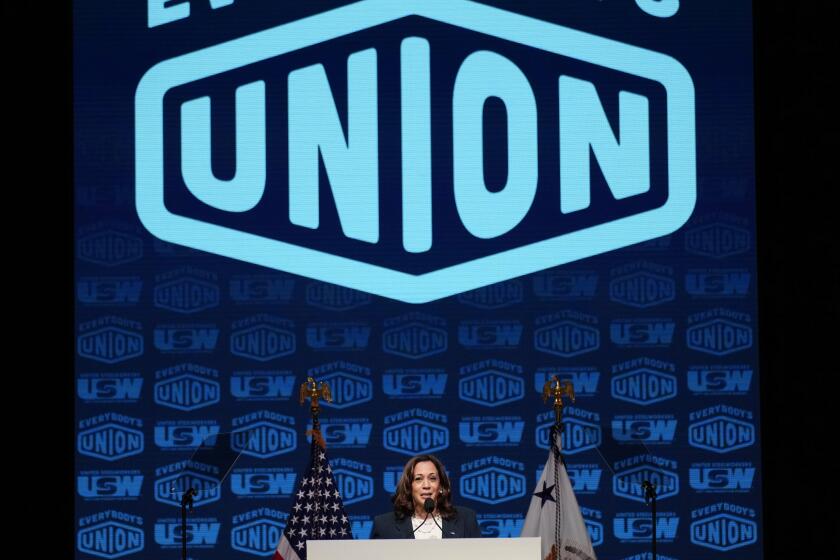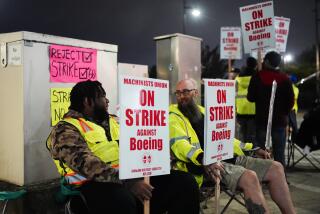Tentative railway labor agreement reached, averting a strike, Biden says

A strike could have halted shipments of food and fuel at a cost of $2 billion a day.
WASHINGTON â Rail companies and their workers reached a tentative agreement Thursday to avert a nationwide strike that could have shut down the nationâs freight trains and devastated the economy less than two months before the midterm elections.
President Biden announced the deal, which emerged from a marathon 20-hour negotiating session at the Labor Department and came just one day before the threatened walkout.
âThis agreement is validation of what Iâve always believed â unions and management can work together ... for the benefit of everyone,â Biden said at the White House.
The deal, which includes a 24% pay raise, will go to union members for a vote after a cooling-off period of several weeks.
The threat of a shutdown carried political risks for Biden, a Democrat who believes unions built the middle class. But he also knew a rail strike could pose grave economic risks ahead of the midterms, when majorities in both chambers of Congress, key governorships and scores of important state offices will be up for grabs.
Biden made a key phone call Wednesday evening to Labor Secretary Marty Walsh as negotiators were talking and being offered Italian food for dinner, according to a White House official insisting on anonymity.
On speakerphone, the president urged both sides to get a deal done and to consider the harm that a shutdown would inflict on families, farmers and businesses, the officials said.
One union had to wake up its board to move forward on the agreement, which involved 50 calls from White House officials to organized labor officials.
Joined in the Oval Office by business and union leaders, a beaming Biden joked that he was surprised everyone was âstill standingâ after the late night and that they should be âhome in bed.â
A strike would have disrupted passenger traffic as well as freight rail lines because Amtrak and many commuter railroads operate on tracks owned by the freight railroads. Amtrak canceled all of its long-distance trains ahead of the strike deadline and was working to restore full service.
Commercial cannabis resulted in corruption and questionable conduct that has rocked local governments across California, a Times investigation found.
The five-year labor deal, retroactive to 2020, also includes $5,000 in bonuses. Railroads agreed to ease their strict attendance policies to address some of the union concerns about working conditions.
Workers will now be able to take unpaid days off for doctorâs appointments without being penalized, and they wonât be penalized if they are hospitalized. Previously, workers would lose points under the attendance systems that the BNSF and Union Pacific railways had adopted, and they could be disciplined if they lost all their points.
The talks also included Norfolk Southern, CSX, Kansas City Southern and the U.S. operations of Canadian National.
The unions that represent the conductors and engineers who drive the trains had pressed hard for changes in the attendance rules, and they said this deal set a precedent that ensures they will be able to negotiate such rules in the future.
Late-night negotiations averted a strike by the nationâs railroad workers, which would have had huge effects on the U.S. and California economies.
Kelly Pettus, who is married to an engineer in Atlanta, said she wanted more details about the attendance policy.
Earlier this year, her husband had to leave work when their 2-year-old daughter ended up in the emergency room with the flu. He spent the entire time worrying about the penalty involved in taking a single day off.
âYou canât just call and say your baby is in hospital,â Pettus said.
Hugh Sawyer, an engineer in the Atlanta area, said the pay raise was long overdue and did not completely make up for the regular cost-of-living increases that he lost several years ago.
âItâs something to build on,â Sawyer said of the deal.
The president on Sunday schooled Newsom on Labor Day politics by endorsing United Farm Workers legislation that could help the UFW organize.
The president of the Brotherhood of Locomotive Engineers and Trainmen, Dennis Pierce, predicted that workers will support the deal if they look logically at all the gains, including the fact that the unions again fought off proposals to cut locomotive crews down from two people to one.
But if workers vote angry, the outcome is harder to predict.
âI think it is going to dramatically change the way these jobs look,â he said.
Victor Chen, a sociologist at Virginia Commonwealth University who studies labor, said concerns about working conditions have increasingly become a priority for unions and their workers.
Experts acknowledge the newfound excitement around labor but caution that unions, which have suffered decades of declining membership, are unlikely to turn the tide.
âAt a certain point, good wages just arenât enough to make up for the toll these sorts of working conditions impose on workers,â Chen said. âThe companies need to treat workers like human beings, rather than just inputs in a business process.â
The railroad unions pointed to workload and attendance rules after the major railroads cut nearly one-third of their workforce â some 45,000 jobs â over the last six years.
The rail industry has aggressively cut costs everywhere and shifted its operations to rely more on fewer, longer trains that use fewer locomotives and fewer employees. The unions said the remaining workers, particularly engineers and conductors, were on call 24/7 because of jobs cuts and could hardly take any time off under strict attendance rules.
Unions had an advantage at the bargaining table because of the tight labor market and ongoing service problems on the railroads, Chen said.
Shippers have complained loudly this year about delays and poor service as railroads struggled to hire quickly enough to handle a surge in demand as the economy emerged from the pandemic. The shipping problems gave rail workers extra leverage.
Breaking News
Get breaking news, investigations, analysis and more signature journalism from the Los Angeles Times in your inbox.
You may occasionally receive promotional content from the Los Angeles Times.
Newly hired CSX Chief Executive Joe Hinrichs said he hopes the new deal helps the railroad hire and retain more employees to address the service problems.
âNow we can move our conversation into how do we work together to grow the business and better serve our customers,â he said.
Union activism has surged under Biden, as seen in a 56% increase in petitions for union representation with the National Labor Relations Board so far this fiscal year, including prominent organizing efforts at Starbucks, Amazon and other companies.
Before the deal was reached, business groups including the Business Roundtable and the U.S. Chamber of Commerce predicted that a rail strike would be an âeconomic disaster.â
The Assn. of American Railroads trade group estimated that a strike would cost the economy more than $2 billion a day and force many businesses to scale back or cease production and consider layoffs.
With the economy still recovering from the pandemicâs supply chain disruptions, the presidentâs goal was to keep all parties talking so a deal could be reached.
Biden also knew a stoppage could worsen the dynamics that fueled soaring inflation and created a political headache for the party in power.
He confronted the same kind of predicament faced by Theodore Roosevelt in 1902 with coal and Harry Truman in 1952 with steel â how does a president balance the needs of labor and business in doing whatâs best for the nation?
Railways were so important during World War I that Woodrow Wilson temporarily nationalized the industry to keep goods flowing and prevent strikes.
So the Biden administration jumped into the middle of the talks. Biden and cabinet officials called both sides, and the Labor secretary participated directly in negotiations.
It was clear the effort had paid off when Biden announced the deal, calling it âan important win for our economy and the American people.â
More to Read
Sign up for Essential California
The most important California stories and recommendations in your inbox every morning.
You may occasionally receive promotional content from the Los Angeles Times.














